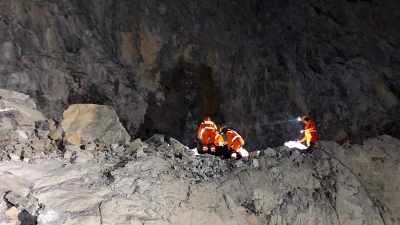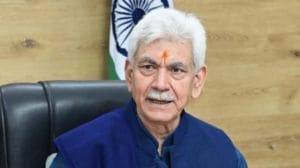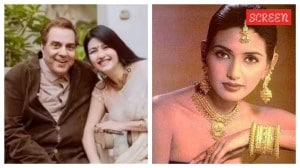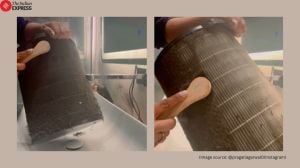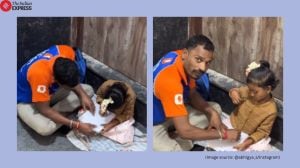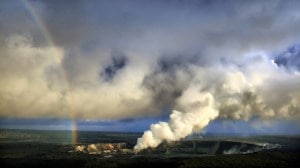Kejriwal decries ‘dictatorship’ at rally: How Ramlila Maidan came to be a political protests theatre
Ramlila Maidan has had a long tryst with India's politics, much before AAP or Kejriwal came upon the scene. Here is a short history.
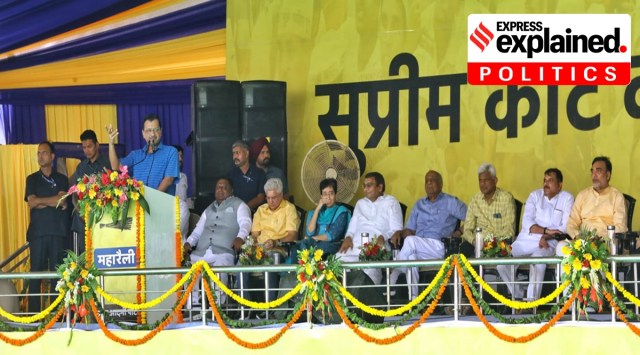 Delhi CM Kejriwal at Ramlila Maidan on June 11. (Express Photo: Abhinav Saha)
Delhi CM Kejriwal at Ramlila Maidan on June 11. (Express Photo: Abhinav Saha) Delhi Chief Minister Arvind Kejriwal Sunday (June 11) addressed a rally at New Delhi’s Ramlila Maidan, saying the Centre bringing in an ordinance to effectively sideline the Delhi government was “dictatorship”.
“What does the ordinance say? Modiji’s ordinance says there will be no democracy in Delhi. There is dictatorship,” Kejriwal said.
The ordinance grants control over aspects of the Delhi government to the L-G, who is appointed by the Centre.
“It doesn’t matter who the people choose, I will run Delhi, Modiji says… Don’t think that this is happening to only Delhi. I have heard they are planning to bring a similar ordinance for the rest of the country as well. An ordinance like the one for Delhi is like the declaration of dictatorship. It will be brought in Maharashtra, Rajasthan, Punjab, Madhya Pradesh,” Kejriwal said.
The venue for the Delhi CM’s speech, Ramlila Maidan, is the same venue where the Aam Aadmi Party was formed and where three successive Kejriwal governments were sworn in. Ramlila Maidan was also where the better part of the anti-corruption movement of 2012 had played out, with activist Anna Hazare and Kejriwal at its helm.
However, the Ramlila Maidan has had a long tryst with India’s politics, much before AAP or Kejriwal came upon the scene. Here is a short history of the Ramlila Maidan, the scene of much political churn over the decades.
A marker of separation
Ramlila Maidan was formed by filling up a pond in the 1930s under the British government. For years, it has been the site of the Ramlila first started under Mughal emperor Bahadur Shah Zafar, thus getting its name.
Vinayak Bharne, then professor of planning at the Sol Price School of Public Policy at the University of Southern California, had written for The Indian Express in 2012 of the Ramlila Maidan, “It was here in June 1975 that Jayaprakash Narayan led his mammoth rally with over a lakh people protesting against Indira Gandhi’’s government. It was here, following the Emergency, that several anti-Congress opposition leaders hosted a rally to form the Janata Party. Ironically, the origins of this maidan could not have been more “non-democratic”. It was part of a cordon sanitaire, a typical planning gesture of new colonial cities, wherein a deliberate physical gap separated indigenous habitats from new ones for supposedly hygienic reasons.
From this standpoint,Ramlila Maidan, a setting for performing democracy, seems so symbolically appropriate —as the charged space of the people bridging two formerly disparate worlds, the historic city of Shahjahanabad and the colonial capital of New Delhi, now, unified as one in democratic India.”
Venue for many historic events
The year 1955 saw Nikita Khrushchev and Nikolai Bulganin as part of a Soviet visit, while former General and then President Dwight Eisenhower delivered a speech at the Maidan in 1959, all hosted by then Prime Minister Jawaharlal Nehru. Two years later, Queen Elizabeth II would make her first visit to India, speaking to a massive gathering at the Maidan, nine years after she had been crowned.
A far more significant event happened in 1975, when Gandhian leader Jayaprakash Narayan gave a speech against then Prime Minister Indira Gandhi, and hours later, she announced the Emergency.
Indira had on June 12 lost a petition in the Allahabad HC against her wherein she had been charged with malpractices in her election to Lok Sabha in 1971. Her election win from Rae Bareli was declared void. After the Supreme Court granted her partial relief, she refused to resign as PM.
JP called a massive rally in Ramlila Maidan on June 25, where he announced a weeklong satyagraha to press for Indira’s resignation. He also appealed to the armed forces, police and government employees not to obey the “illegal and immoral orders” of the government.
That same night, as he was being taken to jail, JP made his famous comment of “Vinaash kaale vipreet buddhi (As one’s doom approaches, their intellect works against their best interest)” about Indira’s actions.
JP returned to Ramlila Maidan on February 7, 1977. Addressing another huge rally with lakhs of people, he gave a call to the people not to miss this opportunity to choose between “freedom and slavery”. He stressed that the question this time was not whether the Janata Party or the Congress won in the elections. “The question is whether you and your children and the country will be free or slaves.” “When you stamp your vote,” he reiterated, “you will also stamp yours and the country’s fate. If you miss this opportunity, you may never be able to hold any such meeting in Delhi again.”
On that one count, at least, JP has been proven wrong, and Ramila Maidan has continued to host several rallies of great political significance.






- 01
- 02
- 03
- 04
- 05


